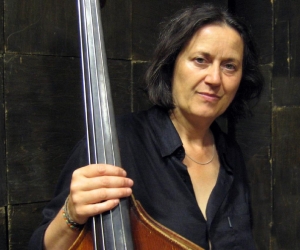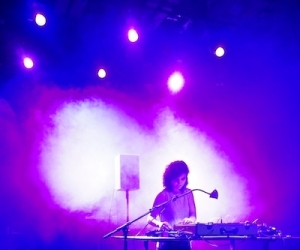
Stories in which the protagonist blossoms, finds themselves, or rediscovers their roots appear everywhere. Their ubiquity makes it awfully tempting to replicate this narrative when telling the story of a solo artist who has arrived at a uniquely focused sound world. Yet sometimes it’s more powerful, and more in line with reality, to illuminate the divergent paths of the protagonist’s route—the detours, the points of culmination—rather than some perceived singular destination.
Colin Stetson understands this well and his work reflects it.
Stetson has become one of the most visible and celebrated saxophonists across a wide range of streams in the musical universe. But it came about through a long, circuitous and—most importantly—ongoing journey. When playing alone, the pulsing, gravelly tones he produces are instantly recognizable.
The pieces he composes for himself are equally identifiable: a tightly woven matrix of polyphonic tones and textures—yet, by the same token, emerging from deeply rooted American song traditions. Beyond his own compositions, Stetson might be known—depending on the listener’s vantage point—as a member of Arcade Fire or as a preferred sideman for The National, Antibalas, Bon Iver, Tom Waits, or Laurie Anderson, to name a few.
Stetson views his journey as a constant process of refinement, refocusing, and rediscovery, where all the various lines of his variegated practice intersect, with a pushing and pulling between asserting himself and exercising restraint. “I think [it was in 1994, while] I was a sophomore, and it was the last year that my previous teacher Chris Creviston was around at the University of Michigan—though he wasn’t my teacher anymore, but we’d play together in various ensembles, and he’d still give me tips after he heard me play. One day he came up after having heard me perform, and said, ‘Great work . . . But have you ever seen The Silence of the Lambs?’ ‘Yeah.’ I responded, to which he said, ‘OK. Well, go watch it again, and pay attention to Anthony Hopkins. Watch how he played that role, and do that next time you play.’
“I didn’t know what he was talking about. I watched that movie so many times. But I really didn’t understand what the fuck he was talking about, until way too recently. What he was getting at was patience in the method of conveying meaning, and it took me a really long time to settle on something like that. When I was younger, everything had to be explosive—every solo I played, every piece of music I wrote, had these huge arcs. Everything was just blowing up left and right. I don’t think I had the wisdom for the slow burn, or the patience to keep something and to really look at the minutiae of a situation or scene. I needed to establish the room and keep the camera on wavering for so long that from memory you could describe every bit of furniture, every accoutrement . . . But I think it’s something that I’m finally doing with this music.”
There is a tangible core of restraint and discipline that tempers the unfolding of Stetson’s work. It’s becoming increasingly clearer as his catalogue grows, yet throughout the more contemplative pieces on his latest release, New History Warfare Vol. 3: To See More Light, the film metaphors are equally palpable. “I like to think about film, fiction, and other media when I’m making music, and find that having that all close in the process of making music makes my conscious intention a little bit clearer in the work.”
It’s not only a question of being informed by images, or even of the cinematic sweep of his sound. His output itself is an intriguing marriage of saxophone wizardry and—whether it’s onstage or in studio—an ever-present element of inventive acoustic cinematography.
In the wake of his second album, 2011’s New History Warfare Vol. 2: Judges, mainstream critics were quick to applaud the originality of his saxophone playing, at times responding as though he’d fallen out of the sky. Yet, it might be more accurate to say that Stetson has, in classic twenty-first-century fashion, carved out a very personal idiom by assimilating various diverse techniques, aesthetics, and influences. He’s certainly had his work cut out for him, given the sizable historical baggage that the saxophone drags alongside itself. This is simply to say that in today’s experimental music climate, most artists resist the innovation-driven modernist model, opting instead for a more eclectic approach. Stetson is no exception to this.
The sober virtuosity of the likes of Evan Parker, John Butcher, or David Mott (perhaps his most similar predecessor) is audible in his sound and in his formidable precision on the horn; and yet his playing is shot through with the unbridled fierceness of late Coltrane, Peter Brötzmann, and Pharaoh Sanders.
In spite of this surface relation to free jazz and improv, though, Stetson’s solo pieces are aimed along a markedly different trajectory. His perception of his own music is pretty unequivocal. “I don’t think of my pieces as sound experiments or some sort of abstraction on timbre and colour. To me they’re very clearly songs. They’re not necessarily consciously based in the world of American folksongs, or prewar gospel music, but I do listen to an enormous amount of that repertoire alongside many classical composers and metal. My diet consists of a lot of highly melodic music and that informs the melodies that come to me when I’m creating.”
In other words, the myriad colours that he excavates from the saxophone are more the engines for a gritty, overdriven, and decidedly modal take on minimalism, than for spontaneous exploration. Patiently channelling the spiralling arpeggiations of early Philip Glass, Tangerine Dream, or Laurie Spiegel, Stetson allies these gestures with his ample grasp of multiphonics and circular breathing, which provides contour, detail, and a sense of polyphony to the endless streams of notes. He also fires his singing voice through the saxophone while playing, providing an additional layer of melody. No sleek ice-rink surfaces here—like the ones occasionally conjured by other purveyors of extended techniques. Rather, his frayed intensity suggests the expressivity of an electric guitarist. Phantom tones and textural disturbances careen into the foreground, obscuring the saxophone in a molten shroud of sculpted acoustic feedback and distortion. And it’s hardly a stretch to tie him to this branch of fretwork, either. “I grew up listening to more Hendrix than anything.
“I actually started playing the saxophone because I liked how the saxophone sounded in rock music,” Stetson says. “I remember being a kid and watching MTV with my brother (this was when MTV was birthed and it was, like, the coolest thing we could imagine.) I remember Men At Work’s ‘Who Could It Be Now’ was on and I was, like,” [affecting a nasal childlike voice] “I like what that thing is! That is what I’m going to do!
“But Hendrix, the Beatles, Queen . . . these things were always on in my house. I listened to things like Soundgarden, Metallica, and Maiden, but then I was also into Bach, Coltrane, and Zorn. And I didn’t think of anything like guilty pleasures, I listened to whatever I thought was great, whether it was rocking, heart-wrenching, or patient and contemplative.”
While his sound radiates rockist energy, the guitarist metaphor only carries so far. As his liner notes categorically state, he never electronically processes his sound, or even overdubs, edits, or loops his sax parts. No matter how exotic, thick, or downright electric the sound, it’s always completely acoustic—the product of Stetson interacting with the instrument, exciting the space in which he’s playing.
That’s not to say that his recorded body of work is devoid of studio technique. There may not be any fancy effects, but on disc his performances are brought to life by his use of an elaborate methodology that strongly suggests film technique. The strobing latticework of his compositions is captured in a cinematic three dimensionality by a battery of microphones that capture sounds from various parts of the instrument, the room, and even Stetson’s body. The mixing of these sources mimics cinematic zooms, pans, dolly shots, and every imaginable auditory–camera-angle around him, constructing a constantly evolving panorama of sound. At times, the listener is situated far away and hears him like insect wings—a coarse, barely perceptible sizzle. At other times, though, they’re thrust into extreme proximity, where the aural density is harrowing and near suffocating.
Over time, Stetson has developed a very clear vision of how to reproduce his sound within the context of a recording. “I was constantly thinking of it as geodesic dome and having all of these different angles of microphone picking up different reflections in a room, picking up different distances from the instrument, because all of these different things are happening acoustically. If you’re standing right next to the instrument, you’re hearing all the different partials of a chord and the melody that’s being voiced on top, you’re hearing the vocalizations that rumble through and out of the instrument, you’re hearing the percussive key claps. And all of these things can be manipulated acoustically—you can push and pull them in different directions. But if you just put up one microphone in front of the bell of the saxophone, you’re going to get a very specific and biased snapshot of the sound of that instrument. And you’re going to lose everything that is happening besides what’s coming out of the bell. Also, depending on what kind of microphone that is, it’s also going to filter out a lot of things and just take the picture that it wants to take.
“When I initially went to record the first album of the series, I said, ‘I want an array—a shit ton—of microphones around me and I want them to be all different kinds, and I want to search for all different ways of capturing the lows and the middle voices and the highs and the depth from the instrument in the room.’ Then, taking all these very specific and isolated snapshots, we would reconfigure them in the mixing process.”
This notion of the world of a recording being a separate and distinct entity is not always a sentiment shared by other acoustically minded musicians. Stetson, of course, has a purist streak when it comes to tampering, but indeed, his recording and mixing process is far more creative than one of mere documentation. However intricate, it never loses sight of the physical experience of performance—it’s actually informed by it. “The live performance has the general acoustics of the room, the fact that the audience is there with you, watching with you, breathing with you, the fact that the sound you’re making is actually physically going through their bodies,” he notes. “These things are completely removed from the recorded medium, and you can’t expect to take a two-dimensional snapshot of the music and then just throw it out there and give it to people. I want to give people a life that was very specific to recording.”
Figuring out how to precisely build the aforementioned dome has been an ever-evolving process over the span of the trilogy of records. “Volume One [2008] was a good first attempt at achieving the sketches I had in my head. We weren’t terribly invasive; certain mikes would get very close to the instrument and to me, but with Volume Two I had done a lot of work in live performances, thinking about different things I could do with the instrument and with the miking. So when I came into the studio, I took that initiative and went further with it.”
Stetson hasn’t always been amplified live, because his naturally dense sound easily filled smaller, more resonant spaces. But, “After recording the first album and as the venues I was playing grew bigger, I started having to mike myself. But I didn’t want to do the same thing that I had complained about with putting a single mike on the bell and losing everything else. I couldn’t tour with ten microphones either, though, so I stripped it down to the key elements. There’s an internal microphone that picks up all the fundamental resonances; there’s an external microphone that gets the overall picture—the sound of what’s being reflected off the bell and coming out of the keys of the instrument; and then the contact mikes on the instrument which give percussion, and on my throat which picks up what I’m singing.”
Beneath the dazzling musical tapestries and drastic redesign of the acoustic space, Stetson’s music has a strong connection to storytelling. It manifests itself literally through Laurie Anderson’s narratives that pepper Judges, and on the actual songs found on both it and its successor, 2013’s To See More Light. But according to Stetson, it courses through the music on a deeper, more subliminal level as well. “It’s been gradually building over the course of years, just like the process of performing this music, writing it, and living with it. The idea for the title came really generally from the idea of finding meaning in one’s life, but more specifically engaging with your time and place in order to tangibly affect your own history. And the idea of moving things noticeably in your own lifetime in sort of a parable-story form.
“The concept kind of birthed this whole corollary story that isn’t exactly what the albums are about per se, but certainly has informed the arc, the song structure, and the overall thematic structure in the music. With each successive record, I’ve written more of this storyline.”
While the music courts a relationship with imagery, it’s a far cry from nineteenth-century tone poems. In fact, the relationship is inverted. “The narrative complements the music. It’s somewhat surrealistic, somewhat sci-fi. I’m always trying to get into the cinematic, instilling into the compositions these greater thematic ideas, emotional concepts, and in some of them, very specific scenes and imagery. In writing this storyline, I was able to inform the movement of the pieces of music and how they all came together in the records. To me, it’s all a form of storytelling.”
Stetson’s solo work may be all about this complex interplay between sound, story, and physical spaces, but Stetson’s process has never been hermetic. In fact, it’s been shaped a by a network collaborators, peers, and mentors as well.
Stetson began playing alto sax at age ten in school, but it wasn’t until he was fifteen that the saxophone assumed greater importance. His first true mentor was the aforementioned teacher Chris Creviston in the late 1990s, then a graduate student at the University of Michigan. He opened the young Stetson up in numerous ways. “When I started with him, I knew what the saxophone sounded like in rock and in jazz, but he’d play it the way it was played in classical music, and it just blew my mind: so gorgeous and intricate and technically dazzling. It immediately floored me and grabbed my attention.”
On top of attuning Stetson’s ears to a different sensibility, Creviston’s guidance and influence also helped Stetson develop a disciplined practice regime. Creviston consistently challenged Stetson to work well beyond his skill level, unbeknownst to the young player. Yet the ploy (and tutelage) very quickly bore fruit. At fifteen Stetson could barely read charts, and by the next year he was winning competitions. By seventeen he had already secured a scholarship to pursue formal training at the University of Michigan. “I never applied to College,” he says matter-of-factly.
Stetson’s enthusiasm and proficiency immediately translated into an all-encompassing and wholehearted commitment to studying music. “When I went into school, I thought that would be my trajectory: go to that school for undergrad, for my graduate degree, get my doctorate, and then get somebody’s job.” he says with a wry chuckle.
Yet his parallel involvement in gigging bands offered a glimpse into a different musical reality, and ultimately contributed to his changing directions after the first four-year phase of his grand plan. “I think it was after doing a recital one day, that I had a very distinct choice to make. It was either to remain in the university setting—and when I performed it would mainly be for other saxophone players, composers, and my mother—or play outside of that context and have an audience of all ages and all types.”
Not only did it influence his decision not to remain in academia, it also started to creep into his aesthetic. “I was starting to take things too far—too far for school, too far for my professor; and the me-now agrees with them. But you’re young and every idea is a big idea. You just don’t see that the context isn’t right for making certain kinds of statements. I got to the point where I was really getting tired of the repertoire. I was pushing it in ways that I thought it needed to be pushed, and was getting some push back from my professor—we had some spirited discussions about that shit! I remember doing some completely freak-out multiphonic solo tenor version of ‘Round Midnight,’ where every note was played in a [multiphonic] chord. I’m quite certain it didn’t sound awesome, but it was part of the path, I guess.”
It was around this time, somewhere near the llate’90s, that the embryonic materials for his solo debut began to take shape as well. On graduating, Stetson and the members of his rock-inflected jazz (sometimes free-jazz) outfit Transmission packed up and moved to San Francisco. Citing Tom Waits and Mike Patton, he notes that, “There were all these guys who seemed to be able to do everything that they wanted to artistically. So it seemed like San Francisco was a good place.” The move ended up being productive in numerous ways, including eventually connecting him with his idol, Waits, who offered additional wisdom. “When I first worked with Waits, I came from a background of playing the saxophone in the typical ways and genres in which the instrument was used. In most of those settings, your personal sound—pressing your ego (ego as in self) into the music—is pretty paramount. You’re playing standards and you’re playing them the way that you play them. Same with how you treat a piece of classical music—injecting the self into all things was how the game was played for me up until that point. I think you’re limited in a sense when your self is on the line in that kind of way. You don’t usually take things down to a level of vulnerability, or that do things that don’t sound proficient.”
“When I worked with Waits I realized very quickly that what he wanted wasn’t about serving yourself. He wanted you to serve the song, to come there, use your life experience and be an actor in a scene—to play a character. So I would do that with him and in an instant he had me playing in ways I’d never explored before. What I got from that was the importance of ridding music of the taint of self and ego.”
Appearing on Waits’ Alice and Blood Money diptych, Stetson began to foster further connections with songwriters, eventually prompting a 2003 move to New York City (where he recorded New History Warfare Volume 1), and then on to Montreal in 2007.
Now a member of Arcade Fire, he’s appeared on records by TV On The Radio, Angelique Kidjo, and Plants and Animals; and he also collaborates with Justin Vernon (a.k.a. Bon Iver) whose voice is a prominent feature of Stetson’s latest effort.
Spanning layered folksy choruses, which allude to barbed guttural shouts representing the precise halfway point between death-metal brutality and Tom Waits, Vernon lends a surprising amount of vocal colour to New History Warfare Vol. 3: To See More Light. His contributions also bring into focus the symbiotic relationship that Stetson shares with song-craft. The tonal quality of Vernon’s singing matches Stetson’s own. Together, their melodic arcs rise above the mysterious thicket of sax texture and push the piece back into the domain of song. To See More Light also contrasts Judges’ bluesier, darker hues with a brighter, more redemptive tone. The choice of cover songs contained on each album illustrates this well. Where Judges sees Shara Worden singing a stark, pale version of the traditional “Lord I Just Can Keep From Crying Sometimes” over a solemn crumbling sax tone, To See More Light has Vernon’s quasi-choral take on Washington Phillips’ “What Are They Doing In Heaven Today?” simultaneously evoking yearning and hope.
The album’s gorgeous closing track, “Part of Me Apart From You,” achieves a similar effect, but without any of Vernon’s vocals. While assertive, fluid, and powerful, Stetson makes maximal expressive use of the demanding physicality of the composition. It’s as though you can hear the beautiful vocal line squeezed out from within his mouth and through an instrument in the throes of bassy resonance.
To See More Light’s more luminous tone also serves to set his work ever further apart from the free-improv world, where many of his chosen techniques were trailblazed. But that’s not to say he’s in any way less innovative. A few critics seem confused in this regard by Judges, taking it simply as a watered-down version of the aforementioned saxophonists, rather than a wholesale transposition of these techniques into a separate medium altogether. Bill Meyer’s review in The Wire perhaps best reflected this spirit, nastily declaring that Stetson’s target audience was “people who aren’t exactly looking for the cutting edge, but who like their entertainment to come with a bit of grime and befuddlement”—this, amidst references to supposedly more legitimate avant-garde figures, including Mats Gustafsson, with whom Stetson released an improv record in late 2012.
But Stetson is not particular about a target audience, nor keen on making such severe distinctions between the cutting edge and mere entertainment—or even between collaborating on a songwriter’s work and crafting his own, for that matter. The more accessible tone of his newest release might make this attitude more transparent to his detractors. “I’ve never understood the concept of identity that’s wrapped up in all of the ways that people listen to music and create their relationships with the music they’re listening to. It gives someone a sense of self, unfortunately. For me, there’s just different music and it all does different things. And some of it does the same thing in different ways. It’s no different from playing it. Whether entirely my own vision and device—like it is with the solo stuff—or if it’s Arcade Fire’s songs that I’m lending my sound to, then there’s not really that much difference, it’s still music that I enjoy, believe in, and want to make a reality.”
Suspicious of identity politics, Stetson’s determination to remain open has been a key factor in maintaining his artistic momentum and inspiring growth over the years. For him, it comes down to actively making choices, not acting out some sort of fate. “A lot of people seem to think that they’re born with a potential and over their lifetime that this will gradually reveal itself to them. And that they’ve always had it within them, but they’re just taking a while to chisel everything else away—a piece of marble and inside is the statue, you’re just waiting to see it revealed. But that’s not the way life works.”
Audio: High Above a Grey Green Sea (2013). Composed and performed by Colin Stetson. Image: Colin Stetson. Image by: Jean-François Bérubé.


